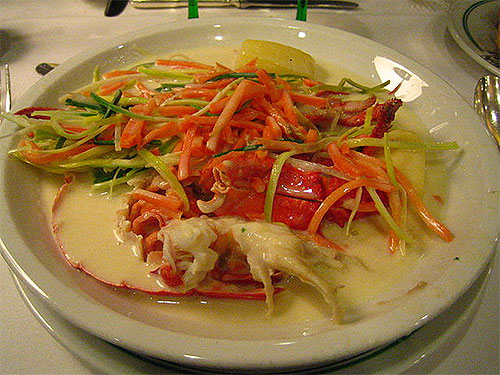| Dish | Place of Origin | Surname | Wine | Farm |
| Beef Bourguignon | Bourgogne | De Villiers | Pinot Noir | Boschendal |
| Bouillabaisse | Provence | Jordaan | Bandol | La Motte |
| Brandade de Morue | Lanquedoc | Theron | Limoux | Zondernaam |
| Classic Rack of Lamb | Bordeaux | Labat | Merlot | Stellenbosch |
| Crêpe | Bretagne | De Villiers | Sauvignon blanc | Porterville |
| Moules à la crème Normande | Normandie | Cronje | Cider | Champagne |
| Quiche Lorraine | Lorraine | Buisset | Riesling | |
| Rillettes | Orleanais | Le Roux | Sauvignon blanc | La Concorde |
| Waterzooi | Picardie | Nortje | Champagne | La Motte |
Also called beef Burgundy, and boeuf à la Bourguignonne, is a well-known, traditional French recipe.
The dish originates from the Burgundy region (in French, Bourgogne) which is in the east of present-day France, as do many of the more well-known French dishes such as coq au vin, escargot, persillé ham, oeufs meurette, gougères, pain d’epices, etc.
It is a stew prepared with beef braised in red wine, traditionally red Burgundy, and beef broth, generally flavoured with garlic, onions and a bouquet garni, with pearl onions and mushrooms added towards the end of cooking.
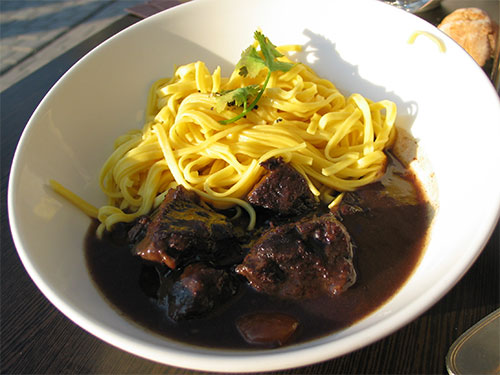 Bouillabaisse
Bouillabaisse
A traditional Provençal fish stew originating from the port city of Marseille. The French and English form bouillabaisse comes from the Provençal Occitan word bolhabaissa, a compound that consists of the two verbs bolhir (to boil) and abaissar (to reduce heat, i.e., simmer).
There are at least three kinds of fish in a traditional bouillabaisse: typically red rascasse (Scorpaena scrofa); sea robin (fr: grondin); and European conger (fr: congre). It can also include gilt-head bream (fr: dorade); turbot; monkfish (fr: lotte or baudroie); mullet; or silver hake (fr: merlan). It usually also includes shellfish and other seafood such as sea urchins (fr: oursins), mussels (fr: moules); velvet crabs (fr: étrilles); spider crab (fr: araignées de mer) or octopus. More expensive versions may add langoustine (European lobster). Vegetables such as leeks, onions, tomatoes, celery and potatoes are simmered together with the broth and served with the fish. The broth is traditionally served with a rouille, a mayonnaise made of olive oil, garlic, saffron and cayenne pepper on grilled slices of bread.
What makes a bouillabaisse different from other fish soups is the selection of Provençal herbs and spices in the broth; the use of bony local Mediterranean fish; the way the fish are added one at a time, in a certain order, and brought to a boil; and the method of serving. In Marseille, the broth is served first in a bowl containing the bread and rouille, with the seafood and vegetables served separately in another bowl or on a platter.
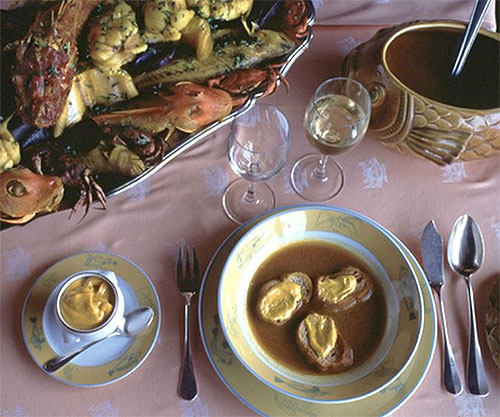 Brandade de Morue
Brandade de Morue
An emulsion of salt cod and olive oil eaten in winter with bread or potatoes. In French it is sometimes called Brandade de Morue and in Spanish it can be called Brandada de bacalao (‘morue’ being the French name for salt cod and bacalao the Spanish one). Brandade is a specialty of the Roussillon, Languedoc and Provence regions of Occitanie (in present-day France); Liguria region in Occitanie (today in Italy) and Catalonia, Balearic Islands and Valencia in the Catalan Countries (now Spain). Similar preparations are found in other Mediterranean countries such as Italy, Portugal and other regions of Spain (for example, atascaburras, which is done with salt cod, olive oil, potato and chestnut) where dried salt cod is also enjoyed.
In Minorca (Balearic Islands, Spain) sometimes artichokes may be added. In Marseilles and Toulon, crushed garlic is added to the dish. Potato is also added to brandade in France and Basque Country, but not in Catalonia. Neither cream nor milk are included in traditional recipes in Occitanie or Spain.
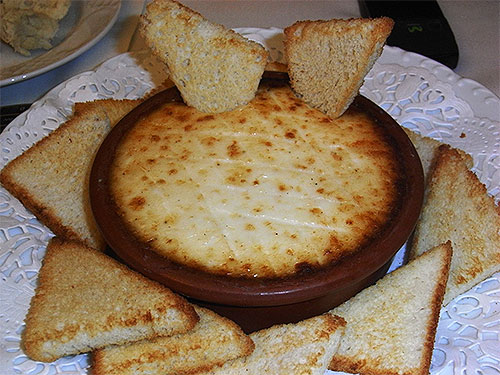 Classic Rack of Lamb
Classic Rack of Lamb
“Frenched”, that is, the rib bones are exposed by cutting off the fat and meat covering them. Typically, three inches of bone beyond the main muscle (the rib eye or Longissimus dorsi) are left on the rack, with the top two inches exposed.
A rack of lamb or carré d’agneau (though this may also refer to other cuts) is a cut of lamb cut perpendicularly to the spine, and including 16 ribs or chops. At retail, it is usually sold ‘single’ (sawn longitudinally and including the 8 ribs on one side only), but may also be sold as a “double rack of lamb”, with the ribs on both sides.
Rack of lamb is usually roasted, sometimes first coated with an herbed breadcrumb persillade. The tips of the bones are sometimes decorated with paper frills resembling chefs’ toques.
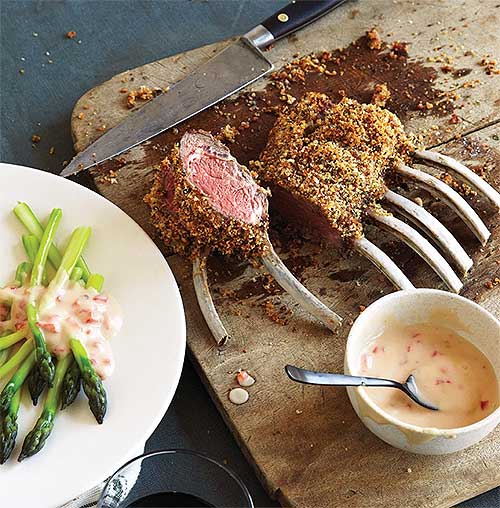 Crêpe
Crêpe
A type of very thin pancake, usually made from wheat flour (crêpes de Froment) or buckwheat flour (galettes). The word is of French origin, deriving from the Latin crispa, meaning “curled”. While crêpes are often associated with Brittany, a region in the northwest of France, their consumption is widespread in France and Quebec. Crêpes are served with a variety of fillings, from the most simple with only sugar to flambéed crêpes Suzette or elaborate savoury .
 Moules à la crème Normande
Moules à la crème Normande
Mussels cooked with white wine, Normandy cider, garlic and cream.
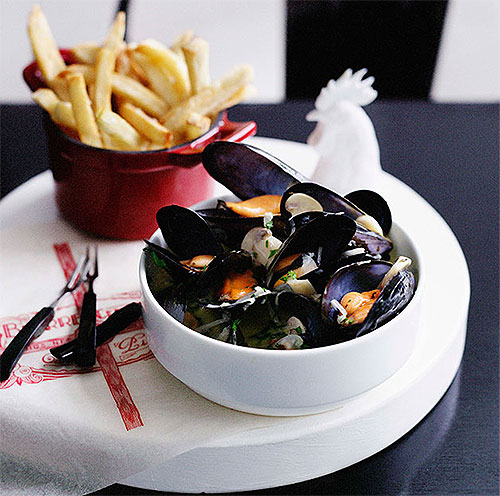 Quiche Lorraine
Quiche Lorraine
The word quiche comes from French, which ultimately borrowed the word from Lorraine Franconian Küeche ‘cake’ (cf. German Kuchen). Central Franconian typically unrounded the ü (/y/) and shifted the fricative “ch” (/ç/) to “sh” ([ʃ]), resulting in “kishe”, which in standard French spelling gives “quiche.”
A popular variant that was originally an open pie with a filling of custard with smoked bacon or lardons. It was only later that cheese was added to the quiche lorraine. The addition of Gruyère cheese makes a quiche au gruyère or a quiche vosgienne. The ‘quiche alsacienne’ is similar to the ‘quiche lorraine’, though onions are added to the recipe. The bottom crust was originally made from bread dough, but that has since evolved into a short-crust or puff pastry crust that is often baked using a springform pan.
The origin of quiche lorraine is in rural Lorraine Region of France and the original quiche lorraine had a rustic style: it was cooked in a cast-iron pan and the pastry edges were not crimped. Today, quiche lorraine is served throughout France and has a modern look. The French version is unlike that served in the United States; the bacon is cubed, no onions are added and the custard base is thicker.
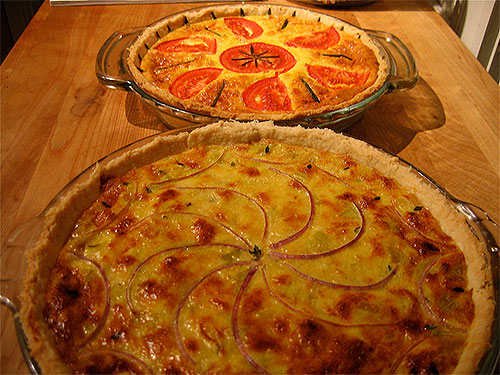 Rillettes
Rillettes
A preparation of meat similar to pâté. Originally made with pork, the meat is cubed or chopped, salted heavily and cooked slowly in fat until it is tender enough to be easily shredded, and then cooled with enough of the fat to form a paste. They are normally used as spread on bread or toast and served at room temperature.
Rillettes are also made with other meats, goose, duck, chicken, game birds, rabbit and sometimes with fish such as anchovies, tuna or salmon.
Sarthe (Le Mans), Tours, and Anjou are notable sources of rillettes.
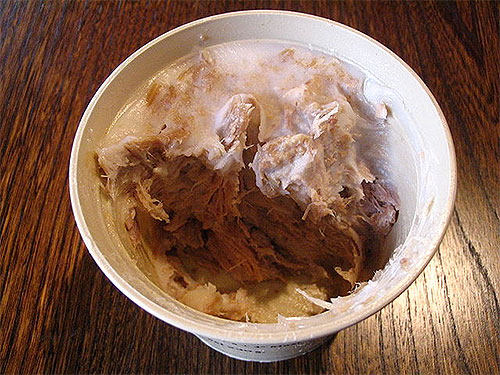 Waterzooi
Waterzooi
A Belgian dish of stew, originating in Flanders. Its name derives from the Dutch term “zooien” meaning “to boil”. It is sometimes called Gentse Waterzooi which refers to the Belgian town of Ghent where it originated. The original dish is often made of fish, either freshwater or sea, (known as Viszooitje), though today chicken waterzooi (Kippenwaterzooi) is more common. The most accepted theory is that rivers around Ghent became too polluted and the fish there disappeared. It is said to have been the favourite dish of Charles V, Holy Roman Emperor who was born in Ghent.
